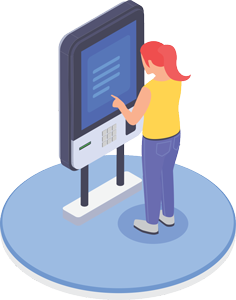Posted on 26 March 2022 by Vinod Rathore

In this era of fast-paced technological advancement, banks and financial institutions are working on digital branch transformation to make banking more convenient for customers as their needs evolve. But here the question is: how can banking transactions be made more accessible and convenient. There are various options for accomplishing this goal, but the most reliable is deploying banking kiosks.
Driven by the increasing demand for interactive kiosks, the bank kiosk market can reach USD 1,311 million by 2026. Financial institutions utilise self-service kiosks to enable clients to access several services without visiting banks because of their propensity to perform effectively in high foot traffic locations. To understand why banks must employ kiosks, let's consider the issues financial institutions face in improving the customer experience.
Challenges for Banks In Handling Customers
Numerous issues compelled banks and financial institutions to use self-service kiosks to provide banking services while maintaining convenience. Effectively managing a large customer base is the main challenge for banks and financial institutions. Long queues exasperate customers as well as put a burden on banking operations. To effectively meet customer expectations, banks have to invest heavy resources. Moreover, in the event of a lack of employees, it becomes difficult for bank officials to explain the situation to customers.
The evolution of customer expectations is challenging banks to make their services more convenient. Today's generation enjoys interacting with machines, raising the bar for digitised experiences. With the rise of data breaches in recent years, security has become one of the most pressing concerns for banks. All these issues push banks to install interactive kiosks to achieve customer satisfaction.
How Banking Kiosks Improve Customer Experience
Kiosks have already proven their worth when it comes to customer service. They aid banks in addressing a variety of issues that affect bank services. In addition to educating customers and allowing them to conduct transactions, there are several advantages of deploying kiosks. Customers get a printed acknowledgement after each transaction, making them more reliable. Biometrics integrations provide customers with an additional layer of security.
The key benefits of banking kiosks are:
No long queues
Fast money transfer, withdrawals, and deposits
Availing banking services without visiting a bank.
Easy to use
Reliable and secure banking experience
24/7 banking services
A self-service kiosk helps in performing various banking transactions with ease. The following are some of the main activities that a customer can access through self-service Kiosks.
Account Opening
Opening an account in a bank is a time-consuming task as one has to fill in details in the form. Account opening applications also add to bank officials' workload. Deploying self-service kiosks allows customers to fill out their personal information on their own and have their accounts activated quickly.
Cash Withdrawal
Traditionally, people fill out a withdrawal slip or a cheque to withdraw money. Banks needed to deploy more human resources and machines to provide quick service. Self-service kiosks have proven to be the safest way to withdraw money.
Cash and Cheque deposit
Depositing cash or cheque is now easy with the help of service kiosks. They allow customers to deposit money and cheque into a beneficiary account.
Fund Transfer
Kiosks transfer money from one bank account to another with minimal or no fees.
In a Nutshell
Banking kiosks have transformed the way customers avail banking services. They are not only beneficial to customers, but they have also proven to be beneficial to banks. They have become an integral part of banks and financial situations, and with technological advancements, it is safe to assume that they have many more roles to perform in the future.
If you are looking forward to deploying self-service Kiosks at your workplace, you can opt for Morezes interactive kiosks that are modular and customisable as per your business need.
Why Moreze?
Fast and secure financial transactions
Biometric-based ID verification
Interactive UI
Multiple connectivity options
Lead generation
Enhanced customer experience
